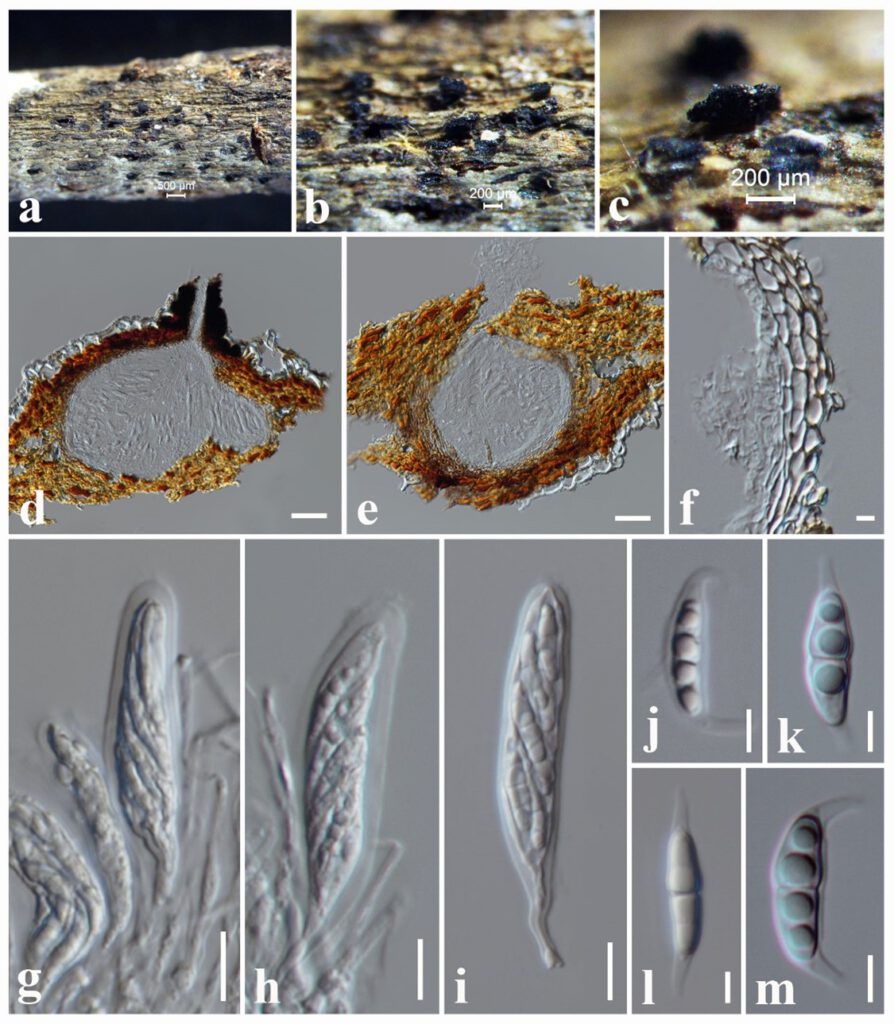Leptoparies magnoliae N.I. de Silva & S. Lumyong, sp. nov.
MycoBank number: MB; Index Fungorum number: IF; Facesoffungi number: FoF 12709, Fig. *
Etymology: Name reflects the host genus Magnolia, from which the new species was isolated.
Holotype: MFLU 18-1291
Saprobic on dead twigs attached to Magnolia sp. Sexual morph: Ascomata 240–290 µm high × 230–270 µm diam., ( = 265 × 250 µm, n = 10), dark brown to black, solitary or scattered, unilocular, immersed to slightly erumpent, subglobose, ostiolate. Ostiolar neck 60–90 µm high × 200–230 µm wide, crest-like, elongated, laterally compressed, composed of globose, brown to black cells, with hyaline periphyses. Peridium 15–25 µm wide, composed several layers of small, brown to dark brown, thin-walled, cells of textura angularis, fusing and indistinguishable from the host tissues. Hamathecium comprising 1–2 μm wide, numerous, filamentous, indistinct septate, cellular pseudoparaphyses, anastomosing at the apex. Asci 40–65 × 8–11 µm ( = 58 × 9 µm, n = 20), 8-spored, bitunicate, fissitunicate, cylindrical-clavate, short pedicellate, apically rounded with an ocular chamber. Ascospores 15–19 × 4–6 µm ( = 16 × 5 µm, n = 30) without sheath, overlapping, uni to bi-seriate, hyaline, fusiform with obtuse ends, slightly constricted at the septum, smooth, guttulate, generally 4 guttules, with a narrow sheath. Sheath drawn out 4–6 μm long at both ends, with a lateral pad, 1–1.5 μm wide at side. Asexual morph: Undetermined.
Material examined: Thailand, Chiang Mai Province, on dead twigs attached to Magnolia sp. (Magnoliaceae), 13 September 2017, N. I. de Silva, NI189 (MFLU 18-1291, holotype).
Notes: According to the multi-gene phylogeny, Leptoparies magnoliae clustered with L. palmarum with 100% ML and 1.00 BYPP support (Fig. 2). Leptoparies magnoliae can be distinguished from L. palmarum in having smaller asci and ascospores. Leptoparies magnoliae is characterized by the smaller asci (58 × 9 µm) and ascospores (16 × 5 µm) whereas L. palmarum is characterized by larger asci (93.9 × 11.9 μm) and ascospores (23.1 × 6.1 μm) [50]. Ascomata of L. magnoliae is smaller (240–290 µm high × 230–270 µm diameter) than L. palmarum (210–320 μm high and 490–650 μm diameter) [50]. Peridium of L. magnoliae is thinner 15–25 µm wide, comprising several layers of cells compared to L. palmarum which is 25–32 μm wide, comprising 3-5 layers of cells [50]. A pairwise comparison of ITS sequence data between L. magnoliae and L. palmarum indicates 16 base pair (3.2%) differences across 500 nucleotides. It is interesting to note that L. magnoliae is the second species recorded for Leptoparies. The first species, L. palmarum was identified by Hashimoto et al. [50] on petioles of Trachycarpus fortunei (Arecaceae) in Japan.

Figure *. Leptoparies magnoliae (MFLU 18-1291, holotype). (a) The specimen. (b, c) Appearance of ascomata on the host substrate. (d, e) Vertical sections through ascoma. (f) Peridium. (g, h) Pseudoparaphyses and asci. (i) Ascus. (j–m) Ascospores. Scale bars: (a) = 500 μm, (b, c) = 200 μm, (d, e) = 50 µm, (g–i) = 10 µm, (f, j–m) = 5 µm.
